Date created: January 2008
Author: SEM WORKS
For further information, contact the author at
SEM WORKS
407 Pebble Ridge Court
Greensboro, NC 27455
Web: www.semworks.net
E-mail: info@semworks.net
Copyright © 2007 by SEM WORKS. All Rights Reserved.
Table of Contents
- INTRODUCTION
- SECTION I: INSIGHTS
- Survey Methodology
- Importance of Campus Safety in College Selection
- Demographically Segmented Importance of Campus Safety
- Gender
- Race
- Geography
- Student Perceptions of Campus Safety Factors
- Campus Lighting
- Number of Campus Security Officers
- Student Specified Factors
- Other Factors
- SECTION II: CONTEXT & STRATEGIES
- Communications Context
- Incident Reporting
- Campus Security Tre
- Government Oversight
- Advocacy Groups
- Communications Strategies
- Understanding Campus Safety Reality
- Understanding Perception
- Identify and Implement Action Steps
- Ten Great Ideas for Communicating Campus Safety
- Communications Context
INTRODUCTION
Campus safety perceptions are at the forefront for many students and parents. Media attention on safety is intense, driven by the April 2007 Virginia Tech tragedy and the increasing levels of public scrutiny of campus environments.
For higher education officials, the challenge is two-pronged: taking appropriate steps to help ensure the safety of their campuses and then communicating those efforts to their constituencies, prospective students, and the public.
Enrollment and public relations professionals face an especially difficult task. While safety may not be a strong positive selling point to attract students, it can be a powerful negative factor that will turn them away.
In fact, campus safety ranked as one of the top five factors in students’ selection of colleges in a recent survey of more than 12,000 college-bound seniors.
SEM WORKS Report: Campus Safety is designed to help colleges and universities understand potential students’ viewpoints on safety and develop strategies that can help build a favorable campus safety image. This in turn will support the entire enrollment management effort to attract new students.
Section I: Insights outlines survey results from more than 12,300 high school seniors in 20 states, providing a window to their views on campus safety and its various aspects.
Section II: Context and Strategies provides a brief review of the current public communications context for campus safety issues, and offers actionable suggestions for incorporating campus safety into your communications plan.
SECTION I: INSIGHTS
A. Survey Methodology
An online survey of more than 12,000 high school seniors was conducted in 20 states, running from January 1, 2007, to April 22, 2007.
The survey gathered data on the factors that influence students’ college choices, and yielded insights on campus safety perceptions. They include:
How important are the following factors when choosing a college? Students rated the overall significance of twelve key factors to their college selection process on a five point scale ranging from Very Unimportant to Very Important. Campus Safety was one of the key factors rated.
How important are the following factors when evaluating the campus safety of a college or university? Students rated eight specific factors related to campus safety on a five point scale ranging from Very Unimportant to Very Important.
What other factors, if any, are important in evaluating the campus safety of a college or university? Students were able to enter an open-ended list of additional factors or contribute other comments.
The survey results are strikingly clear—campus safety is one of the top five factors of students’ evaluation of colleges. The results also illustrate how the importance of safety differs among demographic groups and the specific aspects of campus safety that most influence students’ overall safety image.
B. Importance of Campus Safety in College Selection
Students rated the importance of twelve key factors in their college selection process. When rating campus safety, more than 80% of students indicated that it was somewhat or very important.
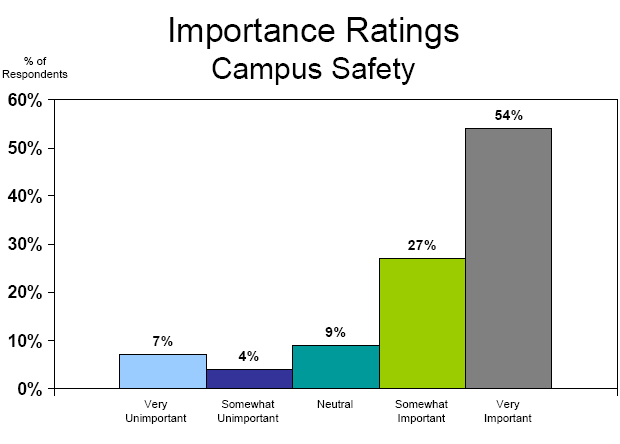
When all twelve key selection factors are compared, campus safety ranks as one of the most significant decision factors. Its overall importance score of 3.18 on a 4.00 scale ranks it fifth among the twelve factors. This score places safety in a tight cluster with the top selection factors of academic strength (3.35), job opportunities for graduates (3.29), academic facilities (3.24), and tuition cost (3.20).
Campus safety ranks well ahead of the remaining college selection factors, which yielded scores ranging between 2.81 and 2.44. Safety was ranked as more important than residential facilities, on-campus social life, campus setting, small class sizes, college size, off-campus social life, and distance from home.
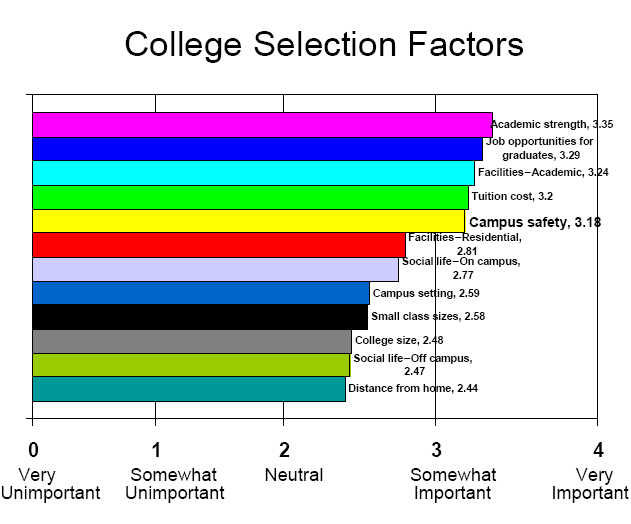
C. Demographically Segmented Importance of Campus Safety
Campus safety’s overall ranking indicates that it is a significant selection factor to all potential students.
Survey respondents provided self-stated demographic information about themselves, aiding our understanding of how student perspectives differ by demographic segment.
When these demographic variables are taken into consideration, clear distinctions emerged in the degree of importance placed on safety by different segments of the student population.
The following data illustrates how safety perceptions vary by five characteristics: Gender, Race, Family Income, Test Scores, and Geography.
Gender, Race, and Geography segmentations yielded the most noticeable differences in perceptions; the least differences occurred in Family Income and Test Score segmentations.
Gender
Not surprisingly, the most notable demographic difference in campus safety perspectives occurs by gender.
Female students consider campus safety a much more important factor in choosing a college than do male students. Safety received a 3.28 importance ranking on a 4.00 scale by females, compared to a 2.94 importance ranking by males.
Women comprise a majority of college students—57% of all students enrolled in 2006–07 according to Department of Education statistics. Thus, campus safety must be addressed by nearly every institution in its marketing communications to prospective students.
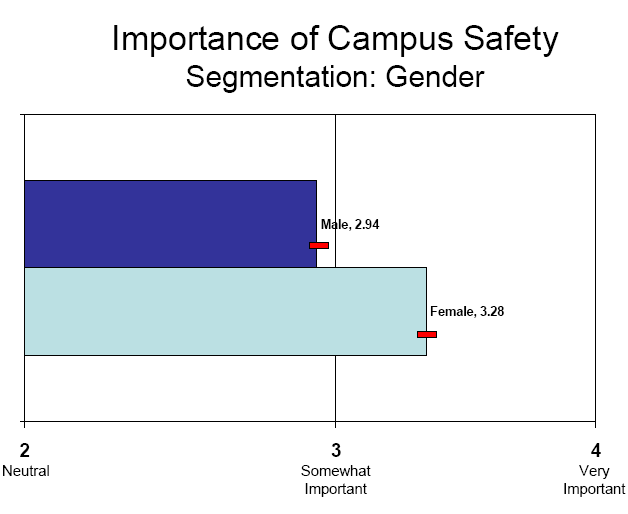
Race
The perceived importance of campus safety differs less dramatically by race than by gender. Nevertheless, it is clear that minority students are more concerned about the safety of college campuses.
Black students rated safety higher than any other racial segment, with a ranking of 3.35 on a 4.00 scale. Asian/Pacific Islander students ranked safety at 3.26, and Hispanic students ranked safety at 3.22. White students ranked safety noticeably lower in importance, at 3.13.
Urban areas across the country generally have a higher percentage of minority citizens than do suburban and rural areas. These urban areas also tend to have a relatively higher crime rate. Therefore, it is likely that differences in campus safety perspectives by racial background also reflect to some degree the geographic distribution of students.
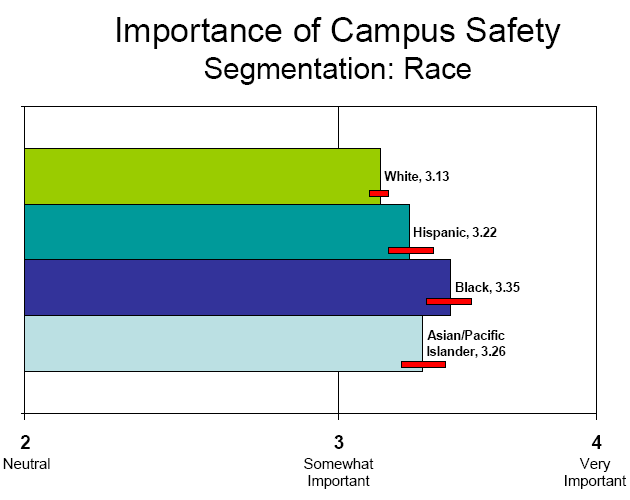
Family Income
Students’ family incomes did not significantly influence their importance rating of campus safety. While the results generally fall within the margin of error, it does appear that students from lower income families may be likely to have a higher sensitivity to safety issues.
Students with family incomes at $75,000 or below clustered their importance rankings of safety between 3.19 and 3.23 on a 4.00 scale, while those with family incomes above $75,000 clustered their importance rankings of safety between 3.10 and 3.05.
Of all income groups, students with family incomes ranging from $25,000 to $50,000 rated safety the highest, at 3.23. They were followed closely by those with family incomes ranging from $0 to $25,000, who rated safety at 3.21, and those with family incomes ranging from $50,000 to $75,000, who rated safety at 3.19.
Students with family incomes ranging from $75,000 to $100,000 ranked safety at 3.10 and those with family incomes ranging from $100,000 to $150,000 ranked safety at 3.07. Students with family incomes of $150,000 or greater ranked safety at 3.05—the lowest importance rating of all income groups.
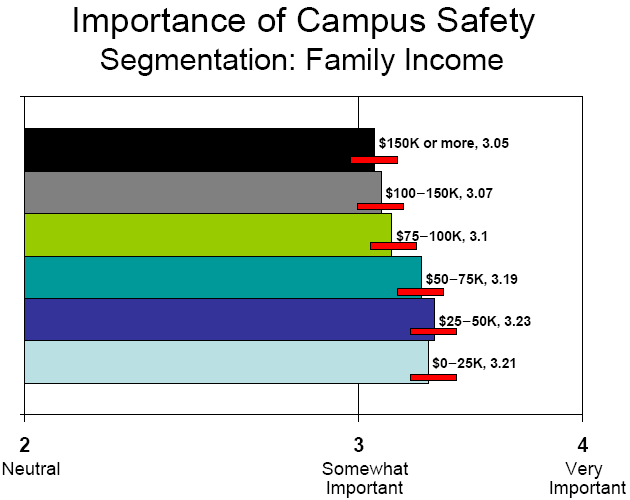
Test Scores
Students’ scores on standardized college admissions tests are only a directional indicator of the importance that they place on safety.
The widely used SAT and ACT metrics were used to group student test performance into six test score categories, as shown in the following table. Category 1 is the lowest test score group and Category 6 is the highest test score group. Students who took neither the SAT nor the ACT were segmented into an additional group.
Importance rankings ranged from 3.34 to 3.08 on a 4.00 scale. Students with the highest scores generally place the least importance on campus safety. Conversely, students with low scores or no scores at all identified safety as a slightly more important factor.
Students in Category 6 and Category 5 (earning 1200 or higher on the SAT and 27 or higher on the ACT) clustered their safety rankings at 3.08 and 3.11, respectively. Students in the remaining Categories 4, 3, 2, and 1 clustered their safety rankings at 3.18–3.23. Students who did not take a standardized test ranked safety the highest in importance at 3.34.
TEST SCORE CATEGORY TABLE
| Test Score Category | SAT Range | ACT Range |
| 1 | 899 or lower | 17 or lower |
| 2 | 900–999 | 18–20 |
| 3 | 1000–1099 | 21-23 |
| 4 | 1000–1199 | 24-26 |
| 5 | 1200–1299 | 27-39 |
| 6 | 1300 or more | 30 or more |
| Haven't Taken | Did not take | Did not take |
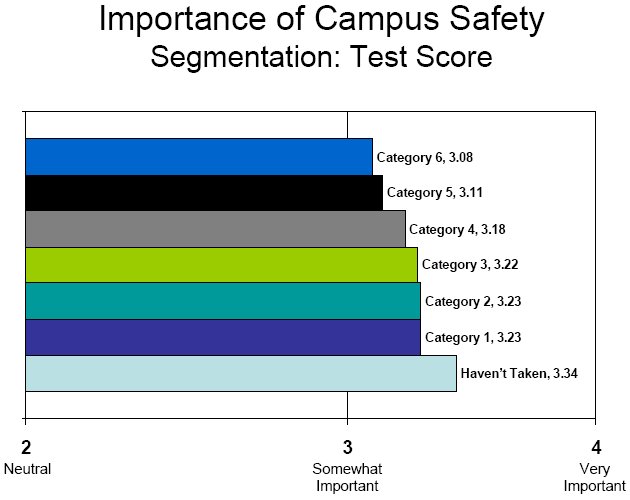
Geography
The geographic segmentation used for this data is based on regions of the country defined by SEM WORKS, as illustrated in the following map.
The survey results suggest that most regions of the country have generally similar views on safety.
The only significant exception is the Mid-Atlantic/South region in which students place greater emphasis on safety than do students elsewhere in the country. Students in that region ranked safety’s importance at 3.33 on a 4.00 scale.
Students in the North Central region may place the least importance on safety, with a 3.07 ranking, although those results fall within the margin of error for the survey.

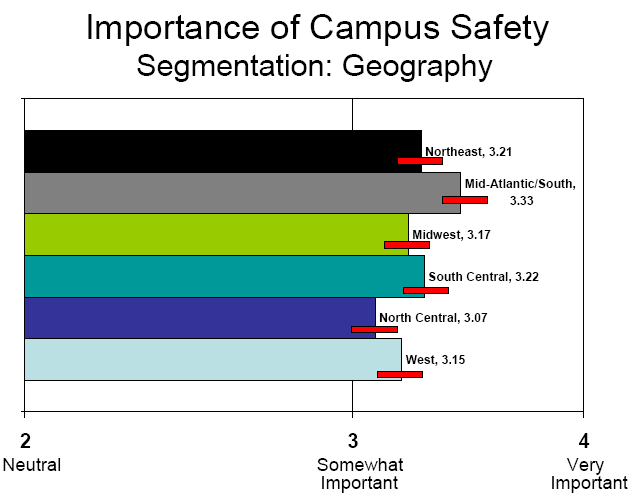
D. Student Perceptions of Campus Safety Factors
Campus safety is a broadly defined feature, with a number of individual components that together form students’ overall perceptions. When considering campus safety, some students may emphasize the number of security officers on campus, while others might emphasize the overall neighborhood setting. Still others might focus on fire control systems in residence facilities or controlled access to those facilities.
The survey asked students to rate the importance of eight specific factors when they considered campus safety. The list of factors was not designed to be comprehensive, but rather to include some of the most common safety factors as determined by SEM WORKS’s prior research.
The eight factors selected for rating are:- Number of crimes committed on campus
- Safety of the surrounding neighborhood
- Fire protection systems in residence facilities
- Lighting of campus areas
- Number of campus police and security officers
- Controlled access to residence facilities
- Frequency of drug and alcohol-related deaths
- Video monitoring of campus
This factor list was supplemented by an open-ended question in which students could list other important safety considerations.
Taken together, the ratings of listed factors and the open-ended comments provide a complete view of how the students themselves define campus security.
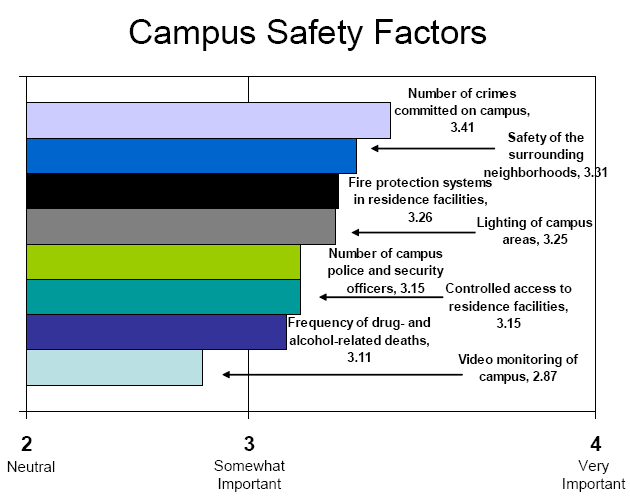
Number of Crimes Committed
Students rated the actual number of crimes committed on campuses as the most important variable when evaluating safety, with a 3.41 importance rating on a 4.00 scale.
While all the factors are important and contribute to perceived safety, the actual number of incidents is the ultimate litmus test. On this question, as was the case with a variety of other questions on the survey, students place much more weight on measurable, tangible outcomes rather than processes and programs.
Open-ended responses supported this finding as well. Respondents encouraged institutions to make campus crime statistics more easily accessible to potential students. There was a notable interest in the frequency of two specific types of crime—burglary and rape.
Safety of Surrounding Neighborhoods
The safety of surrounding neighborhoods was the second most important factor, with a 3.31 rating. It is difficult, if not impossible, to isolate a campus from the community in which it is located. Students, therefore, judge institutions based on their surroundings.
Open-ended comments suggested that colleges located in small towns or rural areas are perceived as safer, while urban campuses are viewed as less secure.
Some respondents distinguished several features that make an urban campus seem more or less safe to them. Urban campuses with heavily traveled community streets and intersections were perceived as more dangerous than institutions that were more isolated from primary traffic flows. The level of gang activity in surrounding neighborhoods was cited as a key factor in making a campus unsafe. Other respondents suggested that urban campuses could be made safer by isolating the college from surrounding neighborhoods with physical barriers such as walls and gates.
Fire Protection
Campus safety is frequently associated with crime, but fires are also very high on the list of risks perceived by students. Fire protection systems in residence facilities received a 3.26 importance rating.
Many students are accustomed to living in single family homes, so the change to multi-unit residence facilities can involve a general level of uncertainty and anxiety regarding fire.
According to an August 2007 National Fire Protection Association (NFPA) report, the number of campus housing fires increased from 1800 in 1998 to 3300 in 2005.1 Between 2002 and 2005 alone, these fires resulted in 39 deaths and nearly 400 injuries. The NFPA attributes the increase to the rising use of electrical equipment by students in their residence hall rooms. Microwaves, hot plates, and other cooking devices were the source of nearly 75% of all the fires. The leading causes of the fatalities were smoking materials (40%), followed by unattended candles (20%).
1 For additional information and resources on campus fires and causes, see the National Fire Protection Association news release of August 21, 2007; http://www.nfpa.org/newsReleaseDetails.asp?categoryID=488&itemID=35781.
Legislative attention to the campus fire issue has been active on the federal level, and public awareness appears to be on the rise as well. In June 2007, the U.S. Senate passed a resolution recognizing September as Campus Fire Safety Month (S.Res. 105), the third year that this public information tool has been utilized.
In July 2007, the Senate passed the “Campus Fire Safety Right-to-Know Act” (S 354). The bill would require institutions to report fire safety information to the U.S. Department of Education and to provide it to the public.
Many colleges and universities are promoting the fire safety aspects of new and upgraded residence facilities, increasing the likelihood that prospective students and their parents will seek similar information for all of the institutions that they are considering.
Campus Lighting
Lighting of campus areas received a 3.25 importance rating.
Taken in context with the open-ended comments, it appears that students are most concerned with campus safety between buildings rather than within buildings.
Students are especially concerned about the narrow, darkened areas and poorly lit parking lots that are distant from classrooms and other buildings.
Number of Campus Security Officers
A slightly lower importance rating for the number of campus security officers—3.15—seems somewhat misleading when taken in context with students’ open-ended comments, which strongly indicate that campus police are very important. This is especially true of female respondents.
The survey question asked students to rate the importance of the number of campus police officers. Their comments, however, indicated that effectiveness of the campus police officers was the critical issue.
Students defined the effectiveness of the campus police force in several key ways:
- Accessibility
- Emergency Access—Students are most concerned that officers can be contacted quickly and easily in the event of an emergency.
- 24/7 Coverage—Campus safety is especially an issue after dark, so students want to be reassured that officers are available on a 24/7 basis.
- Response time—The speed of officers’ response greatly determines students’ perceived safety, especially in emergency situations.
- Visibility—Many students commented that they feel safer when campus police have a visible presence through frequent patrols.
Student Specified Factors
Several items that were not included on the rating list emerged in the open-ended comments as important campus security factors for prospective students. These include the “Blue Light” system, campus escorts, and background checks.
The Blue Light System
The “blue light” system has certainly made a very significant impression on students.
A large number of students cited the availability of emergency call boxes—and specifically the “blue lights” —as a key to a feeling secure.
These emergency contact systems provide a highly visible presence that promotes students’ accessibility to the campus police.
Campus Escorts
Students place a high value on campus escort services.
While most survey respondents appear to prefer escorts from campus police, others appear comfortable with having qualified students as escorts.
The perceived key to a successful escort service is that it be readily available, especially after dark.
Background Checks
A surprising number of respondents commented that background checks of campus employees are an important component of campus security.
Interestingly, a substantial number of respondents also advocated background checks of students themselves.
Most advocates of background checks referred to criminal history, but some went so far as to suggest checks of mental health history.
Other Factors
The three remaining factors included in the survey questions—controlled access to residence facilities, frequency of drug and alcohol-related deaths, and video monitoring of campus— seemed to have the least importance in students’ safety perceptions. Controlled access to residence facilities was rated at 3.15, the frequency of drug and alcohol deaths at 3.11, and video surveillance of campus at 2.87.
While students perceive these factors as relatively less important, institutions should certainly consider these issues in their overall safety plan. Serious incidents can result from the unsecured residence facilities. Students are certainly also made safer by an institutional focus on reducing drug and alcohol abuse. Addressing these issues enhances overall campus security, even if they are somewhat less visible to potential students.
SECTION II: CONTEXT & STRATEGIES
A. Communications Context
Today’s prospective students, parents, and the general public receive information from a plethora of media outlets and technology-driven sources. Inevitably, they will filter institutions’ messages regarding campus safety within this larger context.
An understanding of the main themes and developments that are currently capturing media and public attention provides a useful first step in crafting an effective institutional safety message.
Student Insights’ review of recent media and public information resources identified four key topics that are setting the current communications context: incident reporting, campus security trends, government oversight, and advocacy group efforts.
Incident Reporting
The April 17, 2007, Virginia Tech shooting incident that took the lives of 30 students and faculty was the nation’s deadliest and highest profile campus incident.
Sadly, Virginia Tech was not an isolated incident, as violence on campus continues. Other recent incidents that drew national attention include:
- A student wearing a mask and carrying a .50 caliber rifle was captured and disarmed by campus police at St. John’s University in New York City, September 24, 2007.
- A freshman student shot and wounded two fellow students and fired at a third student at Delaware State University in Dover, September 18, 2007.
- A student was stabbed to death following a roommate dispute at the University of Arizona in Tucson, August 20, 2007.
- A student was raped and murdered in her residence hall room at Eastern Michigan University in Ypsilanti, December 16, 2006. Initial public reports by the university indicated that she died of natural causes. A fellow student was arrested and charged with the crimes in February 2007. The university was found to be in violation of the Clery Act in its handling of the incident, resulting in widespread criticism and ultimately the removal of the president and other top officials in July 2007.
- A shooting incident at Duquesne University in Pittsburgh, September 17, 2006, that seriously injured five high-profile student athletes.
- A shooting rampage at Dawson College in Montreal resulted in one death and 19 injuries, September 13, 2006.
Campus Security Trends
Campus security trends and measures have been heavily followed in the wake of these incidents, especially driven by the Virginia Tech tragedy. Security practices that allow for rapid communication of incidents to the campus community have received particular attention.
Prospective students and parents may frame questions around whether and how specific security measures have been implemented on your campus. They may have already developed strong opinions about these techniques.
The campus security measures most frequently reported in 2007 include:
- Upgraded cell phone and landline systems.
- Mass cell phone messaging capability.
- Cell phone based safety services such as “Guardian,” which allow a student to notify campus security about a planned walk from one area of campus to another, during which time the student’s whereabouts are tracked by GPS using the cell phone, until security is notified that they have arrived safely at their destination.
- Upgraded intercom systems.
- Deadbolt locks on classrooms.
- Security audits and procedure reviews.
- Security assemblies for students and employees.
Government Oversight
Increasing government interest in campus security on state and federal levels has received a high level of media attention. Prospective students and parents are often urged to become familiar with the legal requirements surrounding campus security.
The most frequently referenced oversight vehicles are:
- Jeanne Clery Disclosure of Campus Security Policy and Campus Crime Statistics Act. Initially created as the Campus Security Act of 1990; amended and expanded in 2000.
- Campus Sex Crimes Prevention Act of 2002.
- Senate Bill 354, the Campus Fire Safety Right-to-Know Act, July 2007.
Advocacy Groups Efforts
Several well-known public advocacy groups focus their attention and resources on specific aspects of campus safety. They have generated increasing media attention in the current climate.
The most frequently referenced advocacy groups include:
- Security on Campus, Inc.; King of Prussia, PA; www.securityoncampus.org.
- Campus Firewatch; Belchertown, Massachusetts; www.campus-firewatch.com.
- The Center for Campus Fire Safety; Boulder, Colorado; www.campusfire.org.
B. Communications Strategies
Effective communication is built on a favorable and honest portrayal of an institution. SEM WORKS recommends a simple three-step process for developing communications strategy:
- Determine an institution’s reality
- Understand the perception of key constituents
- Identify and implement steps to improve both reality and perception
Understanding Campus Safety Reality
Each institution has a different campus safety reality. This reality might be defined in a variety of ways, including:
- Statistics such as the number and type of crimes committed on campus or in surrounding neighborhoods.
- The number of campus police officers who are on duty at various times during the day, as well as their response time to incidents.
- The presence or absence of
- Programs such as campus escort services, hotlines, background checks
- Emergency call stations
- Areas of greater danger due to lighting, distance, traffic flows, or other factors
- Safety and awareness classes and training opportunities for students
- Ongoing evaluation of security measures and the frequency of training programs for security personnel. Scrutiny of these practices may become more common, at least in the short term, as institutions’ boards and senior administrators respond to the concerns raised by Virginia Tech and other incidents.
By inventorying and understanding the campus safety “reality” on their particular campus, marketing and enrollment professionals can provide themselves with a valuable tool set from which to build ongoing and need-specific communications regarding safety.
Understanding Perception
Institutions should develop a detailed understanding of how key constituents perceive their campus safety. The constituents include current students, potential students, and the staff.
These perceptions can be determined in several ways.
- Regular interaction—Make a point to talk with students and staff members on a regular basis. Ask their perspectives on campus safety.
- Focus groups—Use a market research company to conduct focus groups of staff and students, current and potential, to develop a qualitative view of campus safety.
- Quantitative surveys—Conduct a survey to gather both quantitative measures and qualitative understanding of campus safety.
SEM WORKS supports institutions by conducting focus groups and quantitative surveys of campus safety perceptions. In addition, SEM WORKS conducts custom surveys of current students and staff to determine their perceptions of campus safety and other features.
Identify and Implement Action Steps
Once institutions have identified both the reality and perception of their campus safety, the next step is to evaluate how well they match and determine and how each could be improved.
In some cases, universities may in reality have a safe campus, but suffer from a negative image due to outdated or inaccurate information in the public context.
In other cases, institutions may in fact need to improve various aspects of their campus security. Effective enrollment and communications programs are built first and foremost on honesty and should never be considered a substitute for addressing actual safety deficiencies in a sincere manner. As these improvements are made, however, it is critical for the college enrollment and marketing staff to communicate them to all constituents.
In many cases, improvements are possible in both the reality and image of an institution’s campus safety.
C. Great Ideas for Communicating Campus Safety
Institutional communications are a team effort. Enrollment and communications professionals must work together to deliver a clear, consistent, compelling message to potential new students and their families. This coordination is especially critical in the development of effective marketing programs addressing public relations, brochures, Web sites, advertising, and other components. Enrollment management personnel then play a primary role in the next phase of interaction with potential students, including personal communications in interviews, events, and campus tours.
SEM WORKS has developed actionable communications strategies that can be used to build a favorable image of campus safety.
- Emphasize Strengths—all institutions have both strengths and weaknesses in campus safety—focus on the strengths.
For example, if a college is located in a dangerous urban neighborhood, it should emphasize the features that separate itself from its surroundings including physical barriers such as gates or natural geographic features and a robust campus police force. - Sell the future—Communicate any and all improvements that are planned.
If a university has a long-term safety improvement plan, make it as tangible as possible in the present. Show illustrations of new features such as emergency call boxes or new lighting. Emphasize specific facts such as timetables and budgets. - Provide proper context—Present accurate and useful comparisons of campus safety.
It is incumbent on the college to establish the context in which statistics are presented. Rather than simply presenting facts, institutions should present accurate and favorable comparisons.
For example, an urban university with a higher crime rate than its immediate suburban and rural competitors should state any statistics in comparison to urban institutions elsewhere. It should state that the university has one of the lowest crime rates of urban institutions nationwide rather than mention a higher crime rate than all institutions in the immediate region. - Use attention-getting facts and stories—Develop a list of memorable facts and stories that will stand out in the minds of potential students.
For example, instead of mentioning the actual campus police response time to an emergency call, an institution could say that “campus police response times are 3 times faster than emergency calls by city police.”
Or instead of mentioning the availability of emergency call boxes, the college could relate a story such as “a student was running to class and fell and broke her leg. A call box was located just 10 feet away, so she contacted the campus police who arrived within two minutes and had an ambulance there within 5 minutes.”
Of course, all facts and stories must be true and relevant. These types of stories can be solicited by focus groups and surveys of students. - Relate on a personal level—Facts and statistics are important, but communication about campus safety needs to connect with people on an emotional level.
It is possible to put a human face on nearly every aspect of campus safety.
Testimonials of current students feeling safe on campus or having a specific positive experience can be used to connect with students and parents alike. Similarly, profiles of officers can put a reassuring face on the campus security. - Choose appropriate images—Pictures used in all forms of communications should not only be chosen to reinforce the feeling of a secure campus, but also be appropriate for the audience.
Female students place a relatively higher importance on campus security. Images of campus security might therefore be more effective if they included female students.
A nighttime image of campus might show an area that is well lit and might include a campus police officer in the background. - Choose the right words—The correct choice of positive words can help build students’ perception of a safe campus.
Many different words could be used when describing campus security, but only certain words are most effective.
Most importantly, negative words should be avoided even when used in a positive context. For example, instead of mentioning that controlled access to residence facilities “prevents unauthorized entry,” it may be better to say it “ensures access to residents only.”
Choosing the right words that give confidence to potential students is especially important among campus tour guides. These guides should be carefully trained and evaluated to ensure that their communications with potential students and families support the overall message of safety. - Use all communications—Reinforce the message of campus safety in all forms of communication.
Students’ views of campus safety are formed by every type of exposure to a college including brochures, letters, advertisements, college fairs, and tours.
Colleges should evaluate every form of communication to ensure it reinforces the message of campus safety.
It is particularly important to train campus tour guides who must deal with campus safety questions that may arise only once potential students actually see the campus. - Don’t inadvertently create a negative image—Be careful to manage the content and timing of communication so that it doesn’t create the perception that there may be problem. This is a difficult balancing act.
For example, if a college has a well-publicized string of drug and alcohol incidents, it is certainly necessary to investigate and develop a plan to eliminate them.
But it is not necessary to issue press releases at every stage of investigation and implementation. Such an overt press strategy may serve only to continually remind potential students and parents that there is or was a problem.
Instead, it may be best to simply acknowledge one time to the public that the school has taken steps to address the situation. Subsequent communications may be limited to talking points that can be delivered one-to-one with potential students who initiate the conversation at a college fair, high school visit, or campus tour. - Be prepared... timing is everything. A prepared communications plan can be the key to successfully reacting to specific campus safety incidents.
Campus safety is a topic that generally becomes newsworthy only when a significant crime or accident occurs on a college campus.
Even when an incident happens at another institution, every college should be prepared to discuss their own campus safety situation with media seeking a local angle to their reporting.
A list of key talking points should be kept current and made available to the entire campus administration. In addition, each institution should have a protocol for who interacts with local media.



